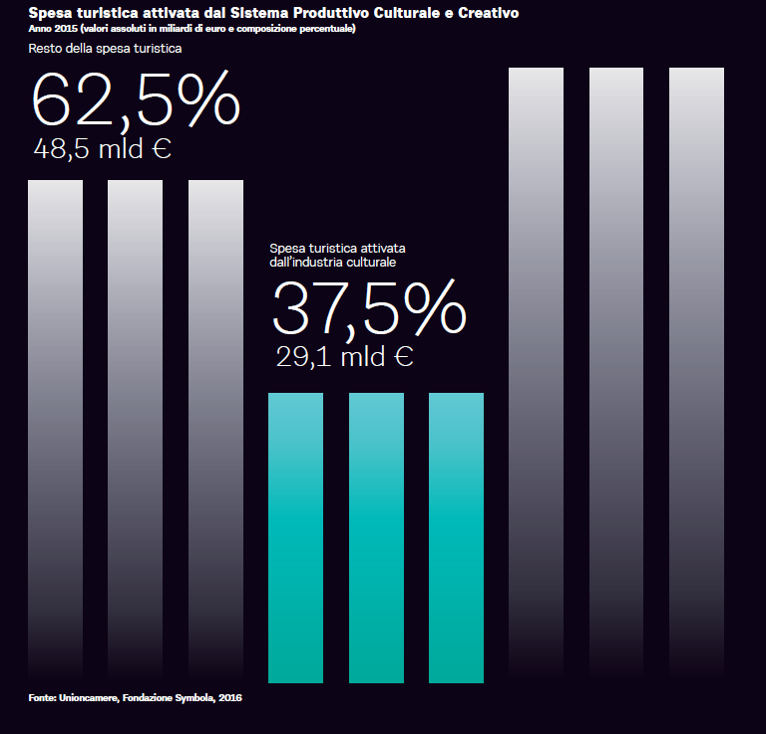Culture and Tourism, fried air or hope for Sicily?
Looking at the years 2011-2015, despite the crisis, in all the Regions of Italy, excluding Sicily and Umbria, we are witnessing a growth in the role of the Cultural and Creative Production System in the regional economies. How come? Some ideas for reflection emerge from reading the Dossier I am culture - 2016 by Unioncamere and from the vision of the state of the art of our Cultural Heritage.
by Ignazio Caloggero
***
In the period 2011/2015, the crisis made itself felt in Italy, negatively affecting the country's added value and employees, respectively with -0,1% and -1,5%, while wealth grew in the cultural and creative sectors. by 0,6% and the employed by 0,2%. The wealth created by the Cultural and Creative sector is close to 90 billion, ie 6,1% of the country's total wealth. Almost 1,5 million people employed in this sector, corresponding to 6,1% of those employed in this case as well.

Dossier: I am Culture -2016
According to a supply chain logic, it is necessary to take into account the "multiplier" effect which means that for every euro produced in this sector almost 2,8 are activated on the rest of the economy, for which we can think that the induced wealth created from the cultural and creative sector is in fact almost 250 billion which corresponds to 17% of the total wealth

Dossier: I am Culture -2016
It is possible to consider the close link that exists between culture and tourism, in fact, of the almost 90 billion mentioned, the tourism expenditure activated by the cultural industry is over 29 billion.

Dossier: I am Culture -2016
But if at a national level the cultural industry accounts for 6,1% of the total wealth of the country and at a regional level it is possible to see the first discrepancies from region to region and we discover how this sector affects the Sicilian economy only for 4,3, XNUMX%

Dossier: I am Culture -2016
Looking at the years 2011-2015, despite the crisis, in all the Regions of Italy, excluding Sicily and Umbria, we are witnessing a growth in the role of the Cultural and Creative Production System in the regional economies.

In terms of incidence of added value at the provincial level, among the first 20 provinces, only Palermo, last in the ranking, is Sicilian

And, if we focus our attention solely on the tourist spending activated by the cultural industry, we discover that no Sicilian province is present among the top 20.

Yet it is known to all that Sicily has an immense Cultural Heritage, especially if seen in all its forms from the tangible one (historical-artistic, landscape and natural cultural heritage) to the intangible one (tradition, folklore, art, food and wine, craftsmanship typical). Without speaking of percentages, linked more to clichés than to anything else, there is no doubt that Sicily is the region with a very high presence of cultural heritage; of the 51 Unesco sites Italians, well 7 are in Sicily and in the next few years they may increase if we consider that other sites are awaiting recognition by UNESCO, not to mention the 3 intangible Unesco sites and to the sites included in the Register of Intangible Heritage of Sicily (REIS) and to the Places of the identity of the Memory of Sicily. (LIM).
Within the intangible heritage of Sicily, the enogastronomic one must also be inserted. Tourists come to Sicily for our climate, our tractions, our monuments and not least for our flavors.

Pupi cradled the egg
Undoubtedly, within the intangible heritage of Sicily, the food and wine also takes on considerable importance. Tourists come to Sicily for our climate, our tractions, our monuments and not least for our flavors. Hence the importance of enhancing I Products Agroceries TItalian radicals (PAT) but also the products, DOP, IGP and TSG.
A comparison, not entirely homogeneous, also in relation to the reference period but which gives an idea of how other territorial realities have a different ability to create wealth from tourism and it is possible to do it with Malta where tourism represents the fundamental sector for the economy Maltese (74,9% of GDP), and in addition to contributing to the growth of gross domestic product to the extent of 25% approximately, occupies the 34% of the entire workforce (2009 data)
Obviously, despite this richness, the data are those indicated by Unioncamere, something is wrong. An answer could be given by reading the recent article published in the Republic which speaks of a degradation of our Cultural Heritage due to a questionable management of the common thing. Here is just the first part of the article:
At the Paolo Orsi in Syracuse it rains inside and the Venus Landolina is reflected in a pool of water. The Villa del Casale is full of weeds and from Piazza Armerina it is unreachable by public transport because they have removed the minibus for tourists: "We don't have a euro at the moment to change a light bulb", say from the Villa. At the Ancient Theater of Taormina there are no funds to secure the upper part, which remains inaccessible to the public. And, again, the cathedral of Agrigento is collapsing. At the following link the rest of the article:
Too many salaries, little money for restorations, the cultural heritage of Sicily is torn apart
We invite you to get to know our cultural heritage through: Data Maps Heritage
Data Maps Heritage is a set of visual databases of cultural heritage at the basis of various thematic or territorial maps. Many innovative features: maps that can be integrated with each other, search for content by name or via free text, georeferencing of content, identification of routes to reach selected places, detailed cards with images and compatibility with mobile device screens.



